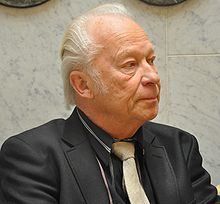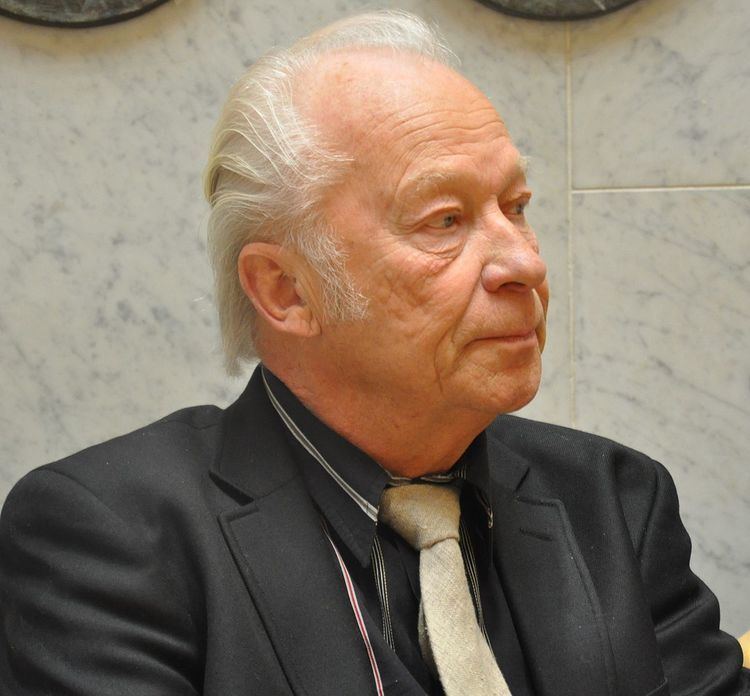Name Aulis Sallinen | Librettists Paavo Haavikko | |
 | ||
Compositions Kullervo, Kullervo, The Horseman, The Horseman, The Red Line, The Red Line, Kuningas lahtee Ranskaan, Kuningas lahtee Ranskaan, Kuningas Lear, Kuningas Lear, Chorali, Chorali, Mauermusik, Mauermusik, Quattro per quattro, Quattro per quattro, Twee liederen voor kinderen en piano, Twee liederen voor kinderen en piano, String Quartet no 3, String Quartet no 3, Kullervo - op 61: Act I - Scene II "Mina tahdon lla tuoksuvaja lammin kuin nuori leipa" (Smith's Young Wife), Kullervo - op 61: Act I - Scene II "Mina tahdon lla tuoksuvaja lammin kuin nuori leipa" (Smith's Young Wife), Kullervo - op 61: Act I - Scene I "Kullervo! Han minut siina unessa tappoi!" (Unto - Unto's Wife - Kullervo), Kullervo - op 61: Act I - Scene I "Kullervo! Han minut siina unessa tappoi!" (Unto - Unto's Wife - Kullervo), Strijkkwartet nr 4, Strijkkwartet nr 4, Symfonie nr 4, Symfonie nr 4, Kamarimusiikki II - op 41, Kamarimusiikki II - op 41, Symphony no 3 - op 35: I Tempo energico ed sostenuto, Symphony no 3 - op 35: I Tempo energico ed sostenuto, Kamarimusiikki I - op 38, Kamarimusiikki I - op 38, Kullervo - op 61: Act I - Scene III "Kullervo - ala mene!" (Mother - Kalervo - Kimmo - Kullervo - Chorus), Kullervo - op 61: Act I - Scene III "Kullervo - ala mene!" (Mother - Kalervo - Kimmo - Kullervo - Chorus), The Iron Age: Suite ('Rauta-aika-sarja') - op 55: I The Wedding Procession of Ilmari and the Goldern Woman, The Iron Age: Suite ('Rauta-aika-sarja') - op 55: I The Wedding Procession of Ilmari and the Goldern Woman, Kullervo - op 61: Act II - Scene VI "Tuli on kohta palanut loppuun" (Kullervo), Kullervo - op 61: Act II - Scene VI "Tuli on kohta palanut loppuun" (Kullervo), Songs of Life and Death - op 69: V I Can Think You Departed, Songs of Life and Death - op 69: V I Can Think You Departed, Sonata per Violoncello e Piano - op 86: Il modo grave e lirico - Epilogo, Sonata per Violoncello e Piano - op 86: Il modo grave e lirico - Epilogo, Symfonie nr 8, Symfonie nr 8, Metamorfosen, Metamorfosen, Sunrise Seranade - op 63, Sunrise Seranade - op 63, Nelja laulua unesta: I Unesta tehty mies, Nelja laulua unesta: I Unesta tehty mies, Symphony no 3 - op 35: III Vivace giacoso - Finale, Symphony no 3 - op 35: III Vivace giacoso - Finale, IJzertijdsuite, IJzertijdsuite, Onnozelaar met zijn hond, Onnozelaar met zijn hond, Symphony no 6 - op 65: III Kyeburn Diggins, Symphony no 6 - op 65: III Kyeburn Diggins, Concerto for Clarinet - Viola and Chamber Orchestra - op 91: I The Dolphin's Lament, Concerto for Clarinet - Viola and Chamber Orchestra - op 91: I The Dolphin's Lament, Metamorphora - op 34, Metamorphora - op 34, Kamermuziek I, Kamermuziek I, Symphony no 5 - op 57 "Washington Mosaics": II Intermezzo I, Symphony no 5 - op 57 "Washington Mosaics": II Intermezzo I, Symfonie nr 1, Symfonie nr 1, Vioolconcert, Vioolconcert, Kullervo - op 61: Entr'acte "Oli kerran mies - jonka hanen veljensa tosissaan yritti tappaa" (Kalervo - Kimmo - Mother), Kullervo - op 61: Entr'acte "Oli kerran mies - jonka hanen veljensa tosissaan yritti tappaa" (Kalervo - Kimmo - Mother), The Iron Age: Suite ('Rauta-aika-sarja') - op 55: VII Lemminki and the Maidens of the Island I-IV, The Iron Age: Suite ('Rauta-aika-sarja') - op 55: VII Lemminki and the Maidens of the Island I-IV, Kullervo - op 61: Act II - Scene IV Interlude, Kullervo - op 61: Act II - Scene IV Interlude, Sonata per Violoncello e Piano - op 86: Serenata, Sonata per Violoncello e Piano - op 86: Serenata, Chaconne, Chaconne, Symphony no 3 - op 35: II Chaconne, Symphony no 3 - op 35: II Chaconne, Concerto for Clarinet - Viola and Chamber Orchestra - op 91: III Adagio del Toro, Concerto for Clarinet - Viola and Chamber Orchestra - op 91: III Adagio del Toro, Winter Was Hard - op 20, Winter Was Hard - op 20, Kullervo - op 61: Act I - Scene I Chorus "Ellospa hyva Jumala", Kullervo - op 61: Act I - Scene I Chorus "Ellospa hyva Jumala", Simppeli Simme ja hamppari Hamme, Simppeli Simme ja hamppari Hamme, Strijkkwartet nr 3, Strijkkwartet nr 3, Variaties voor orkest, Variaties voor orkest, Vier liederen over dromen, Vier liederen over dromen, Symphony no 6 - op 65: I The Islands of the Sounds The Sounds of the Island, Symphony no 6 - op 65: I The Islands of the Sounds The Sounds of the Island, Kullervo - op 61: Act II - Scene V "Itketko - isa - minua kun kuulet kuolleheksi?" (Kullervo - Kalervo - Sister), Kullervo - op 61: Act II - Scene V "Itketko - isa - minua kun kuulet kuolleheksi?" (Kullervo - Kalervo - Sister) Similar People Okko Kamu, Jorma Hynninen, Leif Segerstam, Matti Salminen, Hannu Lintu | ||
Aulis sallinen symphony no 1 1971
Aulis Sallinen (born 9 April 1935) is a Finnish contemporary classical music composer. His music has been variously described as "remorselessly harsh", a "beautifully crafted amalgam of several 20th-century styles", and "neo-romantic". Sallinen studied at the Sibelius Academy, where his teachers included Joonas Kokkonen. He has had works commissioned by the Kronos Quartet, and has also written 6 operas, 8 symphonies, concertos for violin, cello, flute, horn and English horn as well as several chamber works. He won the Nordic Council Music Prize in 1978 for his opera Ratsumies (The Horseman).
Contents
- Aulis sallinen symphony no 1 1971
- Shadows aulis sallinen
- Childhood and studies
- Early adult life
- Later life
- Career highlights
- Symphonies
- Orchestral
- Concertos
- Chamber music
- Operas
- Vocal and choral
- Recordings
- References

Shadows aulis sallinen
Childhood and studies
Sallinen was born in Salmi. During his childhood the family moved several times for his father's work, and during Evacuation of Finnish Karelia in 1944 the family relocated in Uusikaupunki, where Aulis Sallinen attended his schools.
His first instruments were violin and piano. He would play both jazz and classical music. He was known to be extremely creative, and spent much time during his teenage years improvising. After a while, he began writing his ideas down on paper, and began to do serious composition. He attended the Sibelius Academy of Music, and studied with a number of prestigious teachers such as Aarre Merikanto and Joonas Kokkonen.
Early adult life
After graduating, Sallinen took a position as composition teacher at the Sibelius Academy, and continued composing. One of his prominent student was the Austrian born Finnish composer Herman Rechberger. In his mid 20s, he was put on the board of directors of the Finnish Radio Symphony Orchestra. He became chairman of the board of Finnish Composers ten years later. Though he was a known teacher and was on many boards of directors, his compositions were not particularly noted until he was made "Professor of Arts for Life" by the Finnish government, giving him money so he could focus more on composition.
Saline's first opera Ratsumies premiered at Savonlinna in 1974. Together with Joonas Kokkonen's The Last Temptations (1975) its started the golden era of modern Finnish opera. Second opera, Punainen viiva (The red line), was commissioned by Finnish National Opera, third one jointly by Covent Garden and others, and it is called Kuningas lahtee Ranskaan (The King goes to France).
Later life
After receiving the lifelong art professorship, Sallinen devoted great amounts of time to his composing. He has revived standard forms and harmonies, but puts them together in very contemporary ways. He has received a number of commissions from some very renowned ensembles and has composed eight symphonies, including one using material from a proposed ballet on The Lord of the Rings and containing two mediaeval Finnish tunes from the Piae Cantiones. He has written six operas, and is well known as the composer of the title track of the Kronos Quartet's album Winter Was Hard.
